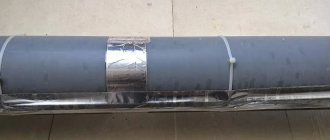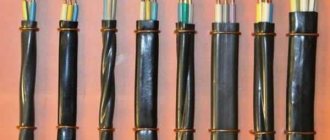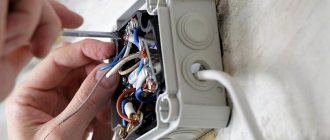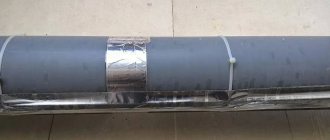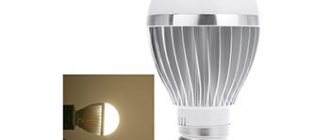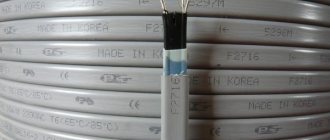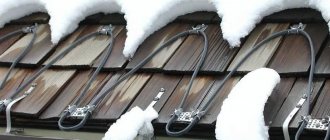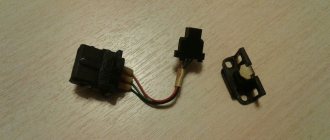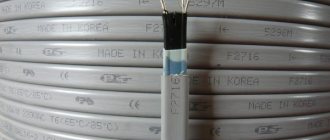Warmth is a necessary condition for a person’s comfortable existence. With the arrival of the cold season, each of us wants to create maximum comfort in our home and avoid all possible problems that arise when the air temperature drops significantly. The heating cable allows you to cope with many tasks of everyday life in winter.
What is a heating cable?
Cable heating systems for both residential and non-residential premises are becoming increasingly widespread. The purpose of using a heating cable is to maintain the required temperature conditions. A cable that converts electrical energy into heat is called a heating cable. A cable heating system helps make life more comfortable.
Heating cable - operating principle and application
A modern heating cable functions like any electric heating device. The higher the resistance of the material to the passage of electric current, the more thermal energy is released on the heating element. The device is connected to an electrical network with a voltage of 220 V, and when electricity passes through it, it generates heat. The heating cable can be used in the following areas:
- heating of floors, walls and ceilings;
- maintaining the temperature regime for hardening concrete becomes especially important in cold weather conditions;
- de-icing of roofs, drainpipes and stairs;
- heated mirrors to eliminate condensation;
- soil heating is widely used in greenhouses;
- preventing freezing of drainage and sewer pipes;
- maintaining the desired temperature of liquid and water, and so on.
Tip 1. Determine for what purposes it is used
Difficulties in carrying out
There is a stereotype that using a guide is irrational. Installation and subsequent operation are so expensive that they do not pay for themselves. It is not always possible for a home owner to dig a trench of the required depth of 1.5 meters. What are the arguments?
- Firstly, the trench requires specialized equipment. It is very difficult to physically dig it out with a shovel.
- You may bump into hard rocks. Then working with hands and a shovel becomes useless.
- For wetlands, the problem of flooding of communications will always be relevant.
- In permafrost regions, communications will freeze one way or another.
- The place where pipes and cables enter the house cannot be protected 100%.
- If local problems are detected, it is easier to mount the wire inside the pipe than to carry out full-scale dismantling work.
And yet, we note that the use of a heating cable can be vital, despite the apparent difficulties.
Three directions of use
- For private buildings. Water supply and sewerage systems are heated. Used for roofing. Mounted at ice formation points. The roof will remain dry in winter. It is the basis of the “warm floor” system.
- Commercial purpose. Used for heating pipelines and fire extinguishing systems.
- Industry. Used for work in hazardous conditions. Mounted for heating tanks, large capacities, and a variety of liquids. This could be: oil industry products, chemicals, etc.
Heating cable - characteristics
When choosing a product, they are guided by the area of application. To choose a suitable cable, you need to consider its main technical parameters:
- Power
. The higher this parameter, the greater the electrical energy consumption and heat generation. - Temperature operating conditions of the cable
. There are three types: high temperature (up to 190°C), medium temperature (up to 120°C), low temperature (up to 65°C).
How much does a heating cable consume?
Everyone who wants to use this invention thinks about this question. In fairness, it is worth noting that the answer depends on many factors, and no specialist will calculate the exact consumption. What does consumption depend on?
- product location;
- weather conditions;
- pipe diameter and thermal insulation;
- power and cable length;
- type of heating cable.
You can approximately calculate the flow rate when using a pipe for heating:
- We find out the nominal consumption indicated by the manufacturer, then find out the length and diameter of the pipe and make calculations. For example, the nominal consumption is 14 W/m, the pipe length is 10 m, and the diameter is 32 d, then the consumption will be 140 W.
- If there is thermal insulation, then consumption is reduced by about half.
- If the cable operates around the clock for a whole month, then multiply 24 hours by 30 days and by the consumed amount of kW/h.
Comparison of heater types
Both types of resistive cable include a heating core that is protected by a sheath. Wire or foil can be used as insulation. The only difference between these cables is that the first has one heating core, and the second has two. The main difference between the wires is the material from which they are made.
Don't forget to calculate the cable length
As a rule, brass, nichrome and copper are used as materials. Each of these metals has different properties and has different electrical resistance values.
When deciding which cable is best to choose, it is worth considering not only the level of its electrical resistance, but also parameters such as the total length and the recommended distance between the heating elements of the wire. This data will allow you to ensure the most suitable floor heating.
The permissible distance between heating elements is determined and indicated on the product box by the manufacturer. At best, doing anything on your own in this matter can render the entire floor system unusable. As a rule, manufacturers regulate the pitch to be no higher than 12 centimeters. Heating wires are sold in a certain length, which requires proper calculations. At the mounting stage, it will no longer be possible to add or remove any part.
Another significant parameter that requires special attention when choosing a cable is the number of heating cores.
Advantages of heating cable
Among the advantages of a heating cable are:
- the ability to independently control the heat supply (when it is necessary to turn the system on and off);
- used in many areas;
- heating cable for pipes lasts a long time (from 25 years);
- ease of use;
- has no harmful effects;
- modern heating cable is resistant to destructive mechanical, chemical, climatic, thermal, and biological effects;
- affordable price.
Video description
How to ground a water supply is shown in the video:
- Most often, for self-installation, a linear cable laying method is chosen.
- The level of heat transfer directly depends on what pipes are installed in the room. For plastic pipes, this figure will not be high, which means that when installing a heating cable for a water supply system, you will need to wrap the pipes with aluminum foil.
- Before attaching a cable to the outside of a metal pipe, it is important to ensure that there is no rust. If there is one, it requires cleaning and treatment with a special antiseptic. If this is neglected, there is a risk of damage to the insulation in the future.
- If fastening is carried out from the outside, then the distance between the insulating bundles should not be more than 30 cm. If you take a wider step, then after a while the fastening elements will separate.
- In practice, some craftsmen pull two wires at once to increase the heating rate. It is important that there is a small distance between the cables.
- For fastening to plastic, it is better to use special clamps.
Fastening with clamps and thermal insulation in section Source yandex.net
- If you decide to twist the wire in a spiral, then initially the pipe is wrapped with metallized tape.
- To fix the insulation, it is better to use special ties. They can be purchased at any hardware store.
- It is necessary to completely isolate the temperature sensor from the electrical cable to eliminate the risk of short circuit and fire. To do this, it is necessary not only to maintain a distance between these devices, but also to make the insulating gasket with a special material.
- Heating the pipelines with a heating cable using a thermostat will ensure constant temperature maintenance. It is better to install this device next to the electrical panel or directly in it. It would not be superfluous to install an RCD.
Wire with thermostat Source www.elektrikaup.ee
Types of heating cable
Experts distinguish two main types of products:
- Resistive
, in which current conductors act as heating elements. This type of heating cable for pipes is being used less and less. - Self-regulating
is the smartest and most convenient to use. This type of self-regulating heating cable is becoming increasingly popular today.
Self-regulating heating cable
This cable consists of one to several cores, insulated from each other by a special sheath. Self-regulating heating cable can be used in various fields. It independently maintains the required operating power and the amount of heat generated depending on weather conditions. The operation of the cable depends on the resistance, that is, if it increases, the current supply decreases, due to which the power decreases. He himself identifies areas where the degree needs to be raised or lowered.
Resistive heating cable
The cable includes one or two insulated cores of a fixed length that cannot be cut independently. This type does not give the chance to change power without using thermostats. This heating cable is used for sewer pipes. There is a subtype of this cable - zonal, consisting of two parallel conductors through which current passes. The heating element is a wire attached to the cores at a fixed distance. This type of cable can be cut along the marked marks.
Application in the national economy
- In construction work, self-regulating cables are used to protect communication systems from icing. In this case, the electrical connection can be located in the inside of the pipeline and on the outside. This circumstance is important when the pipeline from a well or sewage disposal system is laid on the soil surface, and it needs to be protected from icing in the cold season. The situation is similar with foundations located at shallow depths. In this case, the pipeline running from the pumping station to the comb, where the control units are located, also requires additional protection from the cold. Here you should take into account the possibility of cutting off part of the connection of the required length, which will greatly help optimize the electricity consumption required for this system.
To increase the temperature in the internal part of the fresh drinking water supply, compounds are used, the hygienic safety of which is confirmed by a special document. Such cables are installed using special glands and interact with drinking liquid. These are profile connections approved by environmental control organizations;
- To protect against the formation of ice on stairwells, landings, parking lots, and devices for lifting wheelchairs in order to prevent people from receiving various injuries, appropriate temperature increasing systems are also used;
- To protect the roof and its elements from cold , to prevent icing of water removal systems from the roof. Installing a cable can prevent the formation of ice crusts and icicles. If these steps are not taken, damage may occur to the roof, water removal pipes, and cable networks. Falling ice formations from the roof can cause damage to both property and the life or health of people;
- In the gas, chemical and oil industries to increase the temperature inside pipes in a cold atmosphere (in order to prevent them from icing); to increase the temperature of pipes to increase the permeability of substances flowing through them (in order to prevent the appearance of very dense formations and narrowings that interfere with permeability);
- To regulate the temperature of tanks with oil industry products (oil, bitumen, tar, etc.). The same is true for chemically active solutions, substances, etc. Security measures make it possible to prevent property damage;
- In the food industry , they increase the temperature of the drainage pipes of refrigeration units, generate evaporation in refrigeration units, warm drainage trays from the compartments of refrigeration units, and increase the temperature of the crankcases of piston types of pumps before activating them in cold conditions. In addition, self-regulating cables increase the temperature of individual food, fresh water and fire-fighting tanks;
- To increase the temperature of the earth's surface in various agricultural buildings, including greenhouses and premises for keeping livestock. Due to systems based on electrical connections capable of automatic regulation, it becomes possible, at low cost, to create comfortable conditions in such buildings throughout all seasons of the calendar year, which has a good impact on the agricultural industry as a whole.
How to choose a heating cable?
The choice of product depends on the application:
- For the edge of the roof and gutters,
experts advise buying a resistive cable with a power of 12 to 22 W per linear meter or a self-regulating cable with ratings of 20 to 40 W. The second option is suitable for small areas and will save energy. This heating cable fits perfectly into the pipe. - To eliminate ice on steps and landings
, if the cable is laid in a screed, the recommended power of the resistive wire is from 26 to 30 W. If the product is located in sand and not in screed, then the power should be selected no more than 20 W per linear meter. - For water pipes or heating containers
with liquids, it is better to use a self-regulating cable; for plastic pipes, it has a power of 10 W per linear meter, and for metal pipes, up to 20 W.
Alternative heating methods
If for some reason the arrangement of cables is impossible, then the house can be equipped with electrical mats. Such heating devices are very convenient for arranging heated floors, and they require minimal financial costs. If the cost of one meter of self-regulating wire is in the range of 5-10 dollars, then electric mats are much cheaper, and their efficiency is not inferior to a heating cable.
You can find carbon and cable mats on the market. They differ from each other in technical parameters, installation method, production material and operating principle. They are similar to each other only in appearance. Each of the mats is a long thin track that can be easily rolled into a roll.
Cable mats
If you carefully consider how the cable mat is designed, you can understand that it is, in fact, a single-core cable. The only difference is that it is attached to a special mesh like a “snake”. The required distance is maintained between each turn. This kind of heater is best suited for tile coverings, since its entire thickness does not exceed 3 cm.
This heating mat is placed on the floor. The area underneath should be free of bumps and debris. This requirement is due to the fact that the mat is fixed through a special adhesive base located on the underside of the mat. The roll is rolled out, starting with the temperature controller. When it is necessary to rotate the mat, it is allowed to cut the reinforcing mesh, but the wire must not be touched under any circumstances. It can only be rotated at the required angle.
After this, the temperature controller is installed, the wires are laid and the base is glued. Then the system is checked for functionality, after which the film is glued to the floor and covered with tiles or laminate.
Carbon version
A carbon mat assumes the presence of rod heating elements connected to each other like a rope ladder. They have special coatings that, when electrical voltage passes through them, make it possible to emit infrared radiation, which is thermal energy.
Each element of this chain works independently and is not influenced by other rods. The undoubted advantage of this system is that if one of the elements fails, this will not affect the operation of the others. In addition, such a device, like a self-regulating cable for underfloor heating, is capable of autonomously monitoring the external temperature of the situation and responding adequately to it. At the same time, the cost of such devices is much cheaper, and their service life is no less.
There are many options for organizing electric floor heating. Of course, in each case, the selection of a heating element is made individually, taking into account the characteristics of the floor, its external covering, the complexity of installing the system and financial capabilities.
How to connect the heating cable?
Direct connection of the cable is made by connecting it to the unit that performs thermoregulation. Depending on the purpose and scope of application, linear and spiral installation are used, while the wire itself is laid either inside or outside relative to the pipes or another surface.
Most often, when selling heating cables, a thermostatic unit is included. You should try to install it so that it is not affected by the negative environment. The connection of the wires must be sealed. To do this, you can use special clamps and couplings.
Connecting the heating cable takes place in several stages:
- Cable conductors intended for connection are cut in the form of a ladder at various distances and freed from insulating material to a length of 10 mm.
- Heat-shrinkable sleeves are pulled over all existing conductors, and a joint sleeve with a large diameter is attached on top of the cable.
- The ends of the wires are mounted in sleeves and clamped with pliers on one side, and on the other hand they crimp the sleeve after inserting the other ends.
- Couplings with a small diameter are put on the wires and heated with a hairdryer; after clamping, a coupling of a larger diameter is pulled onto the connection area and also heated with a hairdryer.
- If we are talking about self-regulating types of cable, then both end wires are sealed. They are cut in the form of a ladder, a heat-shrinkable sleeve is pulled over them and also heated with a hairdryer.
- The thermostatic regulator, which is necessary to regulate the temperature, is placed close to the electrical panel. To increase safety, an RCD (automatic switching device) is introduced into the thermostatic regulator circuit.
Product installation
Correct installation is the key to correct and durable operation of the equipment. There are several points to consider that you should definitely pay attention to. There are four installation methods:
- Laying the cable in one straight line. It lays flat, without any zigzags or bends. In this method, several cables are most often used at once, which are laid side by side.
- Laying can also be done with a wavy line. In this case, the wire wraps around the pipe a little.
- Spiral laying. The cord is wrapped around the pipe.
- Separate sections of cable that lie along the contour.
A heating cable is a very useful product for use in private homes, as well as any old buildings. In some cases, it becomes an indispensable part of communications.
The advantages of using such a cord:
- Reliability. If all rules are followed during installation, the water supply system will never freeze throughout its entire service life.
- Safety. It can even be installed inside pipes carrying drinking water.
- Wide scope of use. It is used for heating pipes in open areas, as well as underground.
- Easy to use. The heating cord is very easy to install and attach to the pipeline, and it is also easy to connect it to the power supply system.
Using such a wire with a thermostat, you can significantly save electricity. The heating process will occur fully automatically.
Fastening on top of the water pipe
When laying the heating wire externally, you must carefully ensure that no mechanical damage to the insulation and cores occurs. Pay attention to pinches and bends with sharp angles of rotation. The wire itself must be secured very tightly to the pipe. Aluminum tape is used for this. Using a regular one for such a purpose is strictly prohibited.
You might be interested in Tire colors by phase
The first step is to pinpoint the product on the pipe using small pieces of tape. This is done at a distance of approximately 30-50 cm. After such fastening, you can use aluminum tape to walk along the entire length of the cord. This method of fixation will prevent the thermal insulation of the pipes (merilon) from coming into contact with the heating element, as well as better secure the wire, which will not allow it to change its location and will help transfer heat to the pipeline as much as possible.
If polypropylene pipes are used, it is better to stick special foil on them before installing the heating. This can significantly increase heat distribution.
Inner gasket
The internal method of installing heating for a water supply system cannot be used in all pipes. It is used only in cases where the cross-section of the communication elements is larger than 40 mm. In water supply systems with a smaller diameter, the wire will partially block the movement of water. It is quite difficult to supply a long pipe with heating, which is mounted in this way.
But in areas whose length is only a few meters, this is one of the best solutions.
The easiest way to install it is in pipes installed vertically. This must be done using a tee, as well as a special sealing coupling. This will prevent the cable from slipping. In certain situations, external installation would be a more rational solution. In this case, it will be easier to repair any elements.
